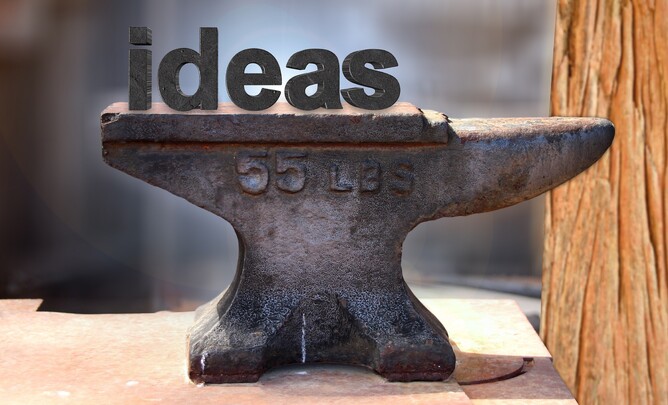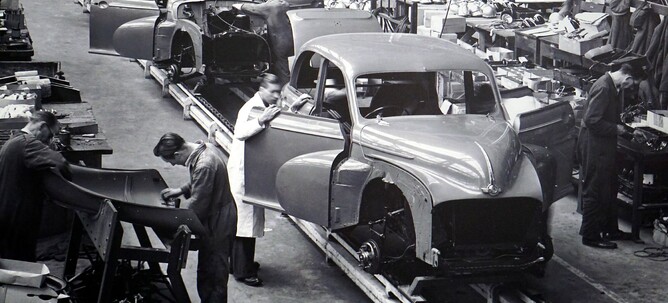How to design a new product
So, you've had an idea and decided 2022 is the year to do something with it. What do you do next?
Please, whatever you do, don't waste a penny on a patent, don't get a prototype made and certainly don't build a website or start marketing it to your potential customers. I know this might sound counter intuitive. But read on and I will explain how you can save your self a lot of time and money.
Over the years we have met many people who have an idea for a product, but don't know what to do next. Some have already spent thousands on trying to develop the idea and are really disappointed, because they either have:
- nice pictures of something that can't be made or
- a patent for something that nobody wants
How do you avoid these pitfalls?
In the spirit of 'Open Design', we have decided to share the Imagination Factory checklist we've developed, as we are passionate about seeing more everyday inventors, 'make their ideas happen'.
Work through each of these steps and discern for yourself if your idea is a product worth developing or something to pursue as a hobby.
Contact us if you want to take your idea to the next stage. We'd love to hear from you. In the meantime, work through the five steps below.
Step 1 - What Kind of Idea is it?
Whilst your idea might be the next Tetrapak or Post-it, until you know that, an objective opinion will help confirm what chance it has of making it off the drawing board. There's a lot of work ahead to get an idea out of the bubble and onto the shelf, so you need to ascertain if others have a positive response to it as well.
Find somebody who's opinion you value (preferably an experienced product designer or commercially minded business person) and ask them to grill you on the idea. But before you say a word, both of you should sign an NDA (non disclosure agreement). This is crucial for both your protection and you should have one in place with anyone you plan to discuss the idea with including friends and family.
The following are the kinds of questions that you will want them to challenge you with.
WHAT'S THE PROBLEM?
Explain the idea to them, starting with the problem it solves:
- How did the idea come about?
- What provoked it or prompted it?
- Is it rooted in a problem you faced or noticed?
- Did it come about because of some work you were doing?
- Is it tech led? Did you see something that inspired you and you want to use it in a different application?
- Have you researched your market? What's the value of it?
- What benefits does your idea offer to people?
- How would you describe its key features?
THE COMPETITION
Who's already done this or something similar?
- What's already out there that's solving the problem in part?
- How successful is it?
- How do you know that?
- Can you quantify their market share or market value?
- How many others are doing it locally or globally?
Don't fall into the trap of believing that nobody out there has had a similar idea. Make sure you search using as many different ways to describe your idea as possible.
DIFFERENTIATION
- What makes your solution different from what's already out there?
- Why might a customer choose your brand or product?
- Will your product do more but cost less?
- Does it use better materials?
- Is there some novel technology that makes it unique?
- Try to be objective and ask yourself, how can I commercialise this idea?
- At this stage in the journey, if you are still excited by the idea and your 'objective input' has not completely killed it, move onto step two.
Step 2 - What Do You Want to Achieve?
So often we hear something along the lines of, "I've got this issue and I've found a way to solve it…I can't believe nobody has done this before" or "somebody has to do something with this it's so good."
Ideas are so infectious that sometimes people can't believe no one else shares their passion, until they've run out of money or time.
In step 1, you have established:
- you are clear about where the idea came from
- you are confident it is solving a problem for more than a handful of people
- there's a solid market for your idea
- or, your idea is a toy, luxury item or something quirky but you are ok with that
Now, you need to consider the effort required for the next phase and establish if you've got what it takes to see it through.
Answer these questions honestly:
- What do you want to get out of this?
- What is your 'why'? What is your mission or your hope – for this idea? (here's a great TEDx talk on Start with why by Simon Sinek on the topic)
- Do you want to set up a business around it and run it yourself?
- Do you want to be the key driver in the development?
- Do you want to find another person to partner with you?
- If you would prefer another to run with it, who might that be?
- Do you want to move on from your current job or situation?
- If so, what is the timescale in mind?
- Are you willing to commit evenings and weekends towards its development?
- Who do you know that might help you with that?
- What are your thoughts on licensing it to somebody else, to get it off the ground?
This is the start of your business model. If you want to lead this potential business or social enterprise, then being clear about your values and intentions from the outset is vital.
Step 3 - What Can You Afford to Put Into It?
Whether your idea is a product you want to make money from or it's a social enterprise – it will require the same amount of effort to make it happen.
That effort really boils down to time, money and skills.
At this point, brutal honesty is key. Save the optimistic thinking for later. You need facts when you answer the following questions, not 'hopeful thinking':
SKILLS
- What skills do you have to bring to the party?
- What skills will you need in your team around you?
- Have you got the design expertise to design your own product?
- Do you have experience in commercialisation or marketing?
- Would you prefer to employ a team of people fresh out of Uni or an agency like The Imagination Factory (depends on how complex your idea is).
- If your idea involves mechanisms or electronics, do you know designers who can help you develop this element of the product?
- Do you know somebody to advise on IP (intellectual property)?
- Do you have experience using IP databases to check your Freedom to Operate?
- Do you understand what is beyond your capability? Make a note of these areas.
TIME
If you had all the time in the world you could learn most or all of the skills required yourself. But as this is unlikely to be your position, estimate on an average month:
- what time you have available outside work
- what personal or family commitments are non-negotiable
Think of yourself as a project manager and look at the time you have to manage this and who you can bring on board to do certain elements.
If you are not clear about the skills or people you might need in a team, here are a few suggestions to help you:
- KTN – Knowledge Transfer Network – part of Innovate UK - connects you with an innovation network and provides early stage business planning advice
- British Library – Business and IP Centre - good place to get advice on IP
- Design Council – lots of resources about the design process
- Cradle to Cradle Product Innovation Institute – resources on how to design sustainably for a circular economy
- Ideo Human-Centred Design Toolkit – resource to help you learn the basics of Human-Centred Design (HCD)
MONEY
Given that it costs between £250,000 and £2 million to research and develop an idea to the point of sale, we never expect people to have anything close to this in the bank when we first meet them. But conversely, you do need a lot more money than a few thousand pounds to get an idea off the ground.
- the development of an idea stretches over a long period, so there are options for raising funds to pay along the way.
- this figure, quoted above, equates to time and skills – some of which you will personally give for free
Our rule of thumb is you won't get far for less than £250K, but what that money really represents is the time spent. You might spend less money, but work on it for years and years, chipping away. You might also have a lot of people around you contributing their time and skills for free, because they are excited to be a part of your dream team.
People sometimes say to us that they saw a new idea on a Crowdfunding site that raised £30k and became a successful product. So, understandably it seems like it should be possible to do something for not too much money.
But there are a number of reasons why this could be mis-leading:
- the inventor might have had access to other sources of funding beyond the Crowdfunding
- the entrepreneur might have had access to any number of the required skills at little or no cost
- delivering 1000 products at a cost of £30 each does not mean they have a successful or sustainable business beyond the campaign
The important thing is to go back to what you decided in Step 2 about your aims for developing this idea. And then be realistic about the time and money that needs to be invested to achieve that. We often call Steps 1 to 3 the Scoping Phase of a product development and it typically takes 1 to 3 months to complete depending on the depth and complexity of the idea.
If you are still convinced your idea has commercial value or will meet the social impact goals you have then move onto Step four.
Step 4 - Design It
Now you're ready to put your idea through a robust design process. This will always include more iteration than you are expecting so we advocate testing ideas often and early using methods that are inexpensive.
Find the major 'bumps in the road' before things get costly.
You can start with what we call 'low fidelity' ie: a card model or some sketches. It allows you to think about how it might function in different contexts, with different users and in different materials. This design will be adapted with each wave of feedback so don't spend too much time and money on it.
We have found that people are more likely to give feedback on something that doesn't look too finished. If it looks like a lot of time has been spent on it people tend to feel less free to criticise it.
You might initially show the models and sketches to people who are easy to access like friends or family, but in some cases you will need input from the specific people that your product is aimed at.
Video the individual or group research, have questions for them throughout the group. Watch it back and observe:
- positive responses
- body language as they interact with the product
- comments that indicate why it's unique or inspiring
- how different genders and ages interact with it
- questions they ask about it
- confusion about it's function
- difficulties understanding
- what they show others in the group
The research phase will help with development, but your findings will also assist you with marketing at a later stage.
Explore your options for the following:
- What is your route to market?
- Are you willing to manufacture abroad or is 'made in Britain' core to your brand?
- What markets can you consider, domestic and foreign?
- Can you develop it and license it to another business for distribution?
- Can you give up your day job and start a crowd funding campaign?
- Would you work in partnership with an angel investor in return for a cut of the business, to assist manufacturing or ensure a solid distribution network?
- Which investors might be a good fit for your idea? Think about their experience, their interests etc.
You will now have a clearer understanding about what you want to protect and where – the technology, as well as what country you will sell it into.
Now you need to move the design to a higher fidelity and you need to put time and perhaps money into trying out the technology, the material or the mechanism.
Look into the following:
- protecting your IP (intellectual property) – seek out a good patent attorney like our friend Charlie at Venture Proof
- source a good design team if you don't have the skills yourself
- apply for funding if you don't have the money.
Excellent organisations experienced with funding ideas include:
Depending on your resources and the complexity of your idea, you can expect the design process to take 6 to 12 months.
Step 5 - Make It
- license the design to someone else to make or
- set up a company to manufacture, market and sell the product
Before you go to manufacture, you want to seal up the design of the product. You don't want to ship products to customers and then have loads of returns because you failed to test the design.
Your design team will need to be capable of 'design for manufacture' and this requires a specific set of skills.
Pre-manufacture, to assist with costing up this step, you will need to find out:
- what design needs to happen for it to be ready for manufacture (ie: the cost in time or money)?
- are there any elements of the design that will require new 'tooling' and what is the cost of this?
Once you are ready to approach a manufacturer, consider the following:
- do you want direct contact with your manufacturer or do you want to delegate this to an agent?
- Where do you want to manufacture? UK or abroad?
- There's always some level of returns. With all the best will in the world and the best manufacturers, something will go wrong. What % of returns can you afford?
- How will you manage it if manufacturing is abroad? Will they go to waste or will you ship them back to the factory?
- What will you do with returns if they do not biodegrade or can not be repurposed?
Probably the single greatest quality you will need to turn your idea into a product is RESILIENCE. So fail fast and often, seek out the people who will ask the challenging questions and find yourself the right team to get you over the finishing line.
Want to know more?
If you have an idea that you want to speak to us about, then please contact us here.





